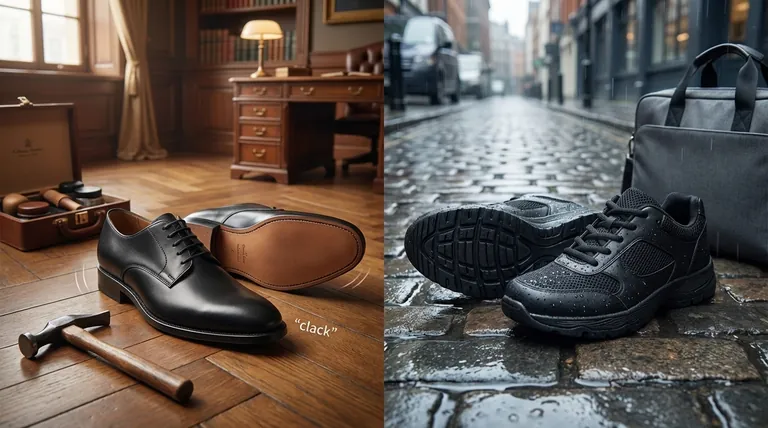The choice between leather and rubber soles fundamentally comes down to a trade-off between traditional elegance and modern utility. Leather offers a formal aesthetic, breathability, and the unique ability to mold to your foot over time for a custom fit. Rubber prioritizes immediate comfort, weather resistance, and superior traction on varied surfaces.
While leather represents the pinnacle of craftsmanship and formal style, rubber is the pragmatic choice for durability and daily comfort. Your decision should rely on the terrain you walk and the impression you intend to make.

Aesthetics and Formality
The Visual Profile
Leather soles are the gold standard for formal footwear. They provide a sleek, low-profile silhouette that is essential for black-tie events and professional business environments.
Rubber soles often appear bulkier or more casual. While modern manufacturing has allowed for slimmer rubber designs, they generally lack the refined edge of a traditional leather sole.
The Sound of Quality
There is a distinct auditory difference. Leather soles produce a crisp, authoritative "clack" on hard surfaces, often associated with high-quality construction.
Rubber soles are significantly quieter. This makes them discreet for office environments but removes the traditional auditory cue of a dress shoe.
Comfort and Mechanics
The Break-in Period
Leather soles are stiff initially. However, their greatest strength is their ability to mold to your foot over time, creating a personalized footbed that becomes incredibly comfortable.
Rubber soles require little to no break-in time. They are flexible right out of the box, offering immediate range of motion for walking.
Shock Absorption
Rubber excels at cushioning. Materials like EVA (ethylene vinyl acetate) or TPU (thermo-polyurethane) compress under weight, absorbing the impact of walking on concrete or pavement.
Leather is harder and offers less impact protection. For long days standing on hard surfaces, a leather sole can lead to foot fatigue faster than its rubber counterpart.
Performance in the Elements
Weather Resistance
Rubber is naturally waterproof. It provides an effective barrier against rain, puddles, and snow, requiring very little maintenance to stay functional.
Leather is porous and susceptible to water damage. Extensive exposure to moisture can warp the sole and shorten the lifespan of the shoe without proper care.
Breathability
Leather allows airflow. Because it is a natural material, it helps regulate temperature and prevents feet from overheating during extended wear.
Rubber can trap heat and moisture inside the shoe. While this is excellent for insulation in cold weather, it can be less comfortable in hot climates.
Critical Trade-offs and Considerations
Traction and Safety
Leather soles can be dangerously slippery on smooth surfaces like carpet or wet marble, especially before they are scuffed up.
Rubber offers natural grip. If you commute on wet city streets or icy sidewalks, the tread and material friction of a rubber sole provide essential safety.
Longevity and Maintenance
Leather soles are sustainable and repairable. A high-quality Goodyear-welted leather shoe can be resoled multiple times, extending the shoe's life for decades.
Rubber soles are generally disposable. While they are extremely durable and abrasion-resistant, once they wear through, they are often harder or impossible to replace depending on the shoe's construction.
Making the Right Choice for Your Goal
To select the right sole, you must assess your daily environment and priorities.
- If your primary focus is Formal Events: Choose leather for its sleek profile, breathability, and traditional elegance that complements a suit.
- If your primary focus is Urban Commuting: Choose rubber for its shock absorption, weather resistance, and superior traction on concrete and wet pavement.
- If your primary focus is Long-Term Customization: Choose leather, as the material will eventually contour to the unique shape of your foot for unparalleled comfort.
Select the sole that supports your day, not just the one that fits the shoe.
Summary Table:
| Feature | Leather Sole | Rubber Sole |
|---|---|---|
| Best For | Formal events, business attire | Urban commuting, daily comfort |
| Aesthetics | Sleek, elegant, traditional | Casual, modern, versatile |
| Comfort | Molds to foot over time (custom fit) | Immediate comfort, excellent cushioning |
| Traction | Low, can be slippery | High, excellent grip |
| Weather Resistance | Low, requires care | High, waterproof |
| Durability & Repair | Repairable, can be resoled | Extremely durable, but often not repairable |
Ready to Source the Perfect Footwear for Your Market?
As a large-scale manufacturer, 3515 produces a comprehensive range of footwear with both leather and rubber soles for distributors, brand owners, and bulk clients. Our production capabilities encompass all types of shoes and boots, ensuring you get the right product mix for your customers' needs.
We help you:
- Expand Your Catalog: Offer a complete selection from formal leather-soled shoes to durable rubber-soled boots.
- Ensure Quality & Consistency: Benefit from our extensive manufacturing expertise and rigorous quality control.
- Scale Your Business: Meet large-volume orders with reliable efficiency.
Let's discuss your specific requirements. Contact our team today to get started!
Visual Guide

Related Products
- Wholesale Durable & Breathable Training Shoes for Custom Brands
- Custom OEM Training Shoes Wholesale Manufacturer Durable & Breathable
- Safety Footwear Wholesale Manufacturer for Custom OEM/ODM Production
- Premium Safety Shoes with Rotating Buckle Safety Sneakers
- Wholesale Leather Ankle Boots with Lug Soles for Custom Brand Manufacturing
People Also Ask
- What is the primary role of shoes in physical activities? Protection, Support & Performance
- Does more ground contact area mean better support? Unlock the Secrets of Stable Footwear
- What is high-tech 'air' mesh, and how is it used in footwear? The Key to Cool, Lightweight Shoes
- What is a Flyknit shoe? The Ultimate Guide to Seamless, Lightweight Performance
- What factors should be considered when choosing footwear for different activities? Maximize Performance & Safety



















